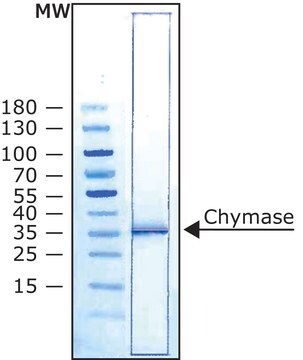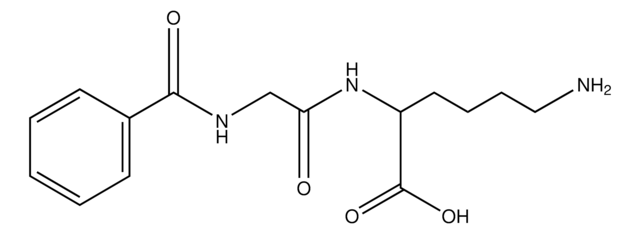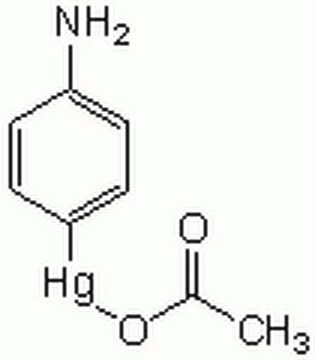PF063
MMP-3, proenzym, ludzki, rekombinowany
Zaloguj sięWyświetlanie cen organizacyjnych i kontraktowych
About This Item
Polecane produkty
Próba
≥95% (SDS-PAGE)
Poziom jakości
Formularz
lyophilized
producent / nazwa handlowa
Calbiochem®
warunki przechowywania
OK to freeze
avoid repeated freeze/thaw cycles
rozpuszczalność
water: soluble
Warunki transportu
wet ice
temp. przechowywania
−70°C
Opis ogólny
Rekombinowany ludzki pro-MMP-3 oczyszczony z supernatantu hodowli komórkowej. Może być stosowany jako kontrola pozytywna lub standard do analizy zymograficznej lub testu substratowego. Wymaga aktywacji do immunoblottingu przed użyciem. M.W. 57000/58000.
Metaloproteinazy macierzy (MMP) to rodzina enzymów odpowiedzialnych za degradację składników macierzy zewnątrzkomórkowej, takich jak kolagen, laminina i proteoglikany. Oprócz homologii sekwencji, wszystkie MMP mają następujące cechy: mechanizm katalityczny zależy od jonu cynku w centrum aktywnym, rozszczepiają jeden lub więcej składników macierzy zewnątrzkomórkowej, są wydzielane jako zymogeny, które są aktywowane przez usunięcie segmentu o masie około 10 kDa z końca N i są hamowane przez tkankowy inhibitor metaloproteinaz (TIMP). Enzymy te są zaangażowane w normalne procesy fizjologiczne, takie jak embriogeneza i przebudowa tkanek, i mogą odgrywać ważną rolę w angiogenezie, zapaleniu stawów, zapaleniu przyzębia i przerzutach. Metaloproteinaza macierzy-3 (MMP-3) znana również jako stromelizyna-1 i transyna (EC 3.4.24.17) rozszczepia szereg substratów, w tym proteoglikan chrząstki, kolageny typu II, III, IV, V i IX, fibronektynę, lamininę i może aktywować MMP 1. MMP-3 jest wydzielana jako proenzymy ~57 i ~59 kDa i może być aktywowana in vitro przez organomercuriale (np, octan 4 aminofenylomocznika, APMA) oraz in vivo przez proteazy poprzez formy pośrednie do aktywnego enzymu MMP 3 o masie 45 kDa. Może również wystąpić dalsza autoliza do formy ~28 kDa. Uważa się, że MMP-3 odgrywa ważną rolę w patofizjologicznych procesach degradacji związanych z takimi schorzeniami jak reumatoidalne zapalenie stawów i inwazja komórek nowotworowych.
Metaloproteinazy macierzy (MMP) to rodzina enzymów odpowiedzialnych za degradację składników macierzy zewnątrzkomórkowej, takich jak kolagen, laminina i proteoglikany. Oprócz homologii sekwencji, wszystkie MMP mają następujące cechy: mechanizm katalityczny zależy od jonu cynku w centrum aktywnym, rozszczepiają jeden lub więcej składników macierzy zewnątrzkomórkowej, są wydzielane jako zymogeny, które są aktywowane przez usunięcie segmentu o masie około 10 kDa z końca N i są hamowane przez tkankowy inhibitor metaloproteinaz (TIMP). Enzymy te są zaangażowane w normalne procesy fizjologiczne, takie jak embriogeneza i przebudowa tkanek, i mogą odgrywać ważną rolę w angiogenezie, zapaleniu stawów, zapaleniu przyzębia i przerzutach. Metaloproteinaza macierzy-3 (MMP-3) znana również jako stromelizyna-1 i transyna (EC 3.4.24.17) rozszczepia szereg substratów, w tym proteoglikan chrząstki, kolageny typu II, III, IV, V i IX, fibronektynę, lamininę i może aktywować MMP 1. MMP-3 jest wydzielana jako proenzymy ~57 i ~59 kDa i może być aktywowana in vitro przez organomercuriale (np, octan 4 aminofenylomocznika, APMA) oraz in vivo przez proteazy poprzez formy pośrednie do aktywnego enzymu MMP 3 o masie 45 kDa. Może również wystąpić dalsza autoliza do formy ~28 kDa. Uważa się, że MMP-3 odgrywa ważną rolę w patofizjologicznych procesach degradacji związanych z takimi schorzeniami jak reumatoidalne zapalenie stawów i inwazja komórek nowotworowych.
Zastosowanie
Immunoblotting (patrz komentarze)
Test rozszczepienia substratu (patrz komentarze)
Zymografia (patrz komentarze)
Test rozszczepienia substratu (patrz komentarze)
Zymografia (patrz komentarze)
Ostrzeżenie
Toksyczność: Standardowa obsługa (A)
Postać fizyczna
Liofilizowany ze 100 mM NaCl, 50 mM HEPES, pH 7,3.
Rekonstytucja
Po rekonstytucji pobrać porcję do silikonowanych fiolek i zamrozić (-70°C).
Komentarz do analizy
Aktywność proenzymu MMP 3 mierzono za pomocą testu rozszczepiania substratu przy użyciu 0,5 mM tiopeptiolidu (Ac-Pro-Leu-Gly-S-Leu-Leu-Gly-Oet) jako substratu. Aktywność oceniano również poprzez degradację substratu peptydowego (DNP-PYAYWMR) przy użyciu aktywowanego MMP-3 mierzonego metodą HPLC.
Inne uwagi
Proenzym MMP-3 może być stosowany jako kontrola pozytywna lub wzorzec do immunoblottingu, analizy zymograficznej lub testów rozszczepiania substratu. Do SDS-PAGE i immunoblottingu użyto 0,5 μg/pas. Do zymografii z kazeiną użyto 1 μg/panel Proenzymu MMM-3 lub aktywowanego MMP-3. Proenzym MMP-3 może być aktywowany in vitro przez inkubację w 50 mM Tris, pH 7,5, zawierającym 0,05% Triton-X-100, 5 mM CaCl2 i 1 mM octanu 4 aminofenylortęciowego (APMA) przez 2-4 godziny w temperaturze 37°C. Aby rozpuścić APMA, należy przygotować 10 mM roztwór podstawowy w 0,05 M NaOH. Około 90% proenzymu MMP-3 jest aktywowane podczas 4-godzinnej inkubacji w temperaturze 37°C przy użyciu 1 mM APMA.
Informacje prawne
CALBIOCHEM is a registered trademark of Merck KGaA, Darmstadt, Germany
Ta strona może zawierać tekst przetłumaczony maszynowo.
Kod klasy składowania
11 - Combustible Solids
Klasa zagrożenia wodnego (WGK)
WGK 1
Temperatura zapłonu (°F)
Not applicable
Temperatura zapłonu (°C)
Not applicable
Certyfikaty analizy (CoA)
Poszukaj Certyfikaty analizy (CoA), wpisując numer partii/serii produktów. Numery serii i partii można znaleźć na etykiecie produktu po słowach „seria” lub „partia”.
Masz już ten produkt?
Dokumenty związane z niedawno zakupionymi produktami zostały zamieszczone w Bibliotece dokumentów.
D Cottam et al.
International journal of oncology, 2(6), 861-872 (1993-06-01)
In order for tumor cells to colonise secondary organs and tissues it is necessary for them to be able to complete all the essential steps of the metastatic cascade. We discuss here some of the important aspects of this process
J F Woessner
FASEB journal : official publication of the Federation of American Societies for Experimental Biology, 5(8), 2145-2154 (1991-05-11)
Matrix metalloproteinases are an important group of zinc enzymes responsible for degradation of the extracellular matrix components such as collagen and proteoglycans in normal embryogenesis and remodeling and in many disease processes such as arthritis, cancer, periodontitis, and osteoporosis. A
S Netzel-Arnett et al.
Analytical biochemistry, 195(1), 86-92 (1991-05-15)
Four new fluorogenic heptapeptide substrates have been synthesized with sequences that are optimized for five human matrix metalloproteinases (MMP). All four substrates are similar to one recently reported by Stack and Gray (1989, J. Biol. Chem. 264, 4277-4281) and have
D E Kleiner et al.
Analytical biochemistry, 218(2), 325-329 (1994-05-01)
Zymography is an electrophoretic technique used to identify proteolytic activity in enzymes separated in polyacrylamide gels under nonreducing conditions. It has been used extensively in the qualitative evaluation of proteases present in tumors and cell culture conditioned media. Using commercially
L A Liotta et al.
Seminars in cancer biology, 1(2), 99-106 (1990-04-01)
The invasion and metastasis of cancer cells is a complex multistep process involving attachment of tumor cells to the basement membrane, proteolysis of the local connective tissue stroma, and migration through the proteolyzed stroma. Recent evidence implicates metalloproteinases such as
Nasz zespół naukowców ma doświadczenie we wszystkich obszarach badań, w tym w naukach przyrodniczych, materiałoznawstwie, syntezie chemicznej, chromatografii, analityce i wielu innych dziedzinach.
Skontaktuj się z zespołem ds. pomocy technicznej








